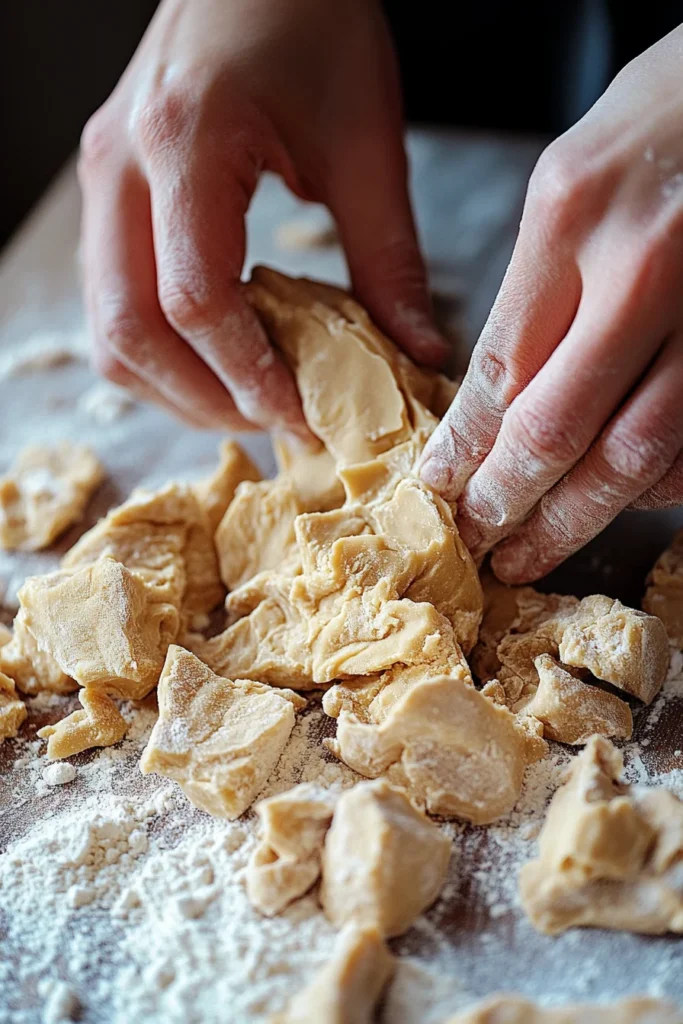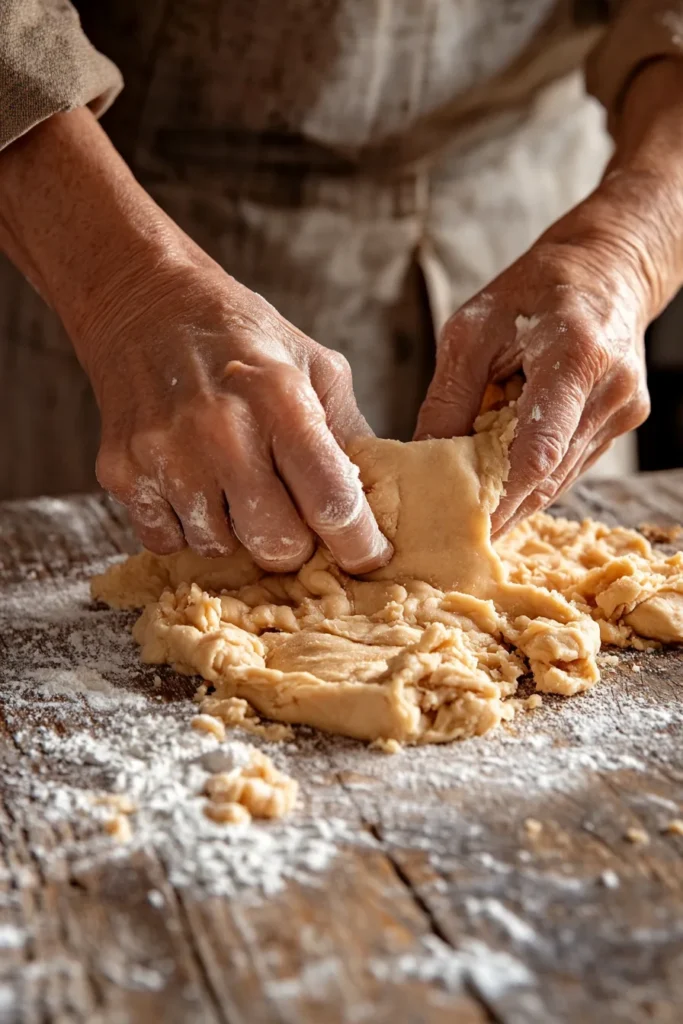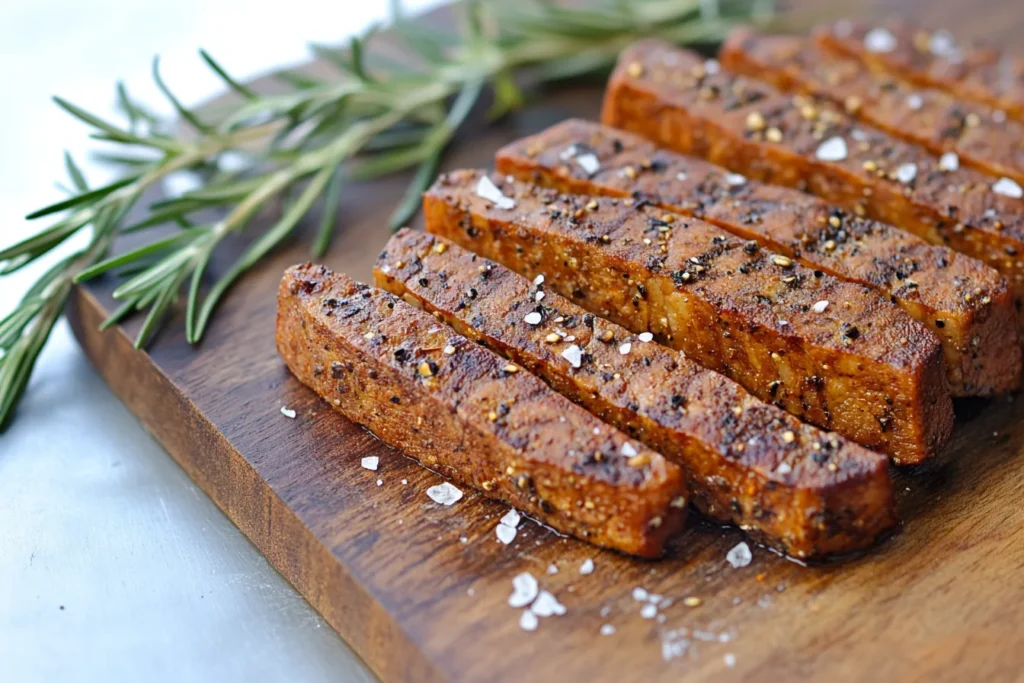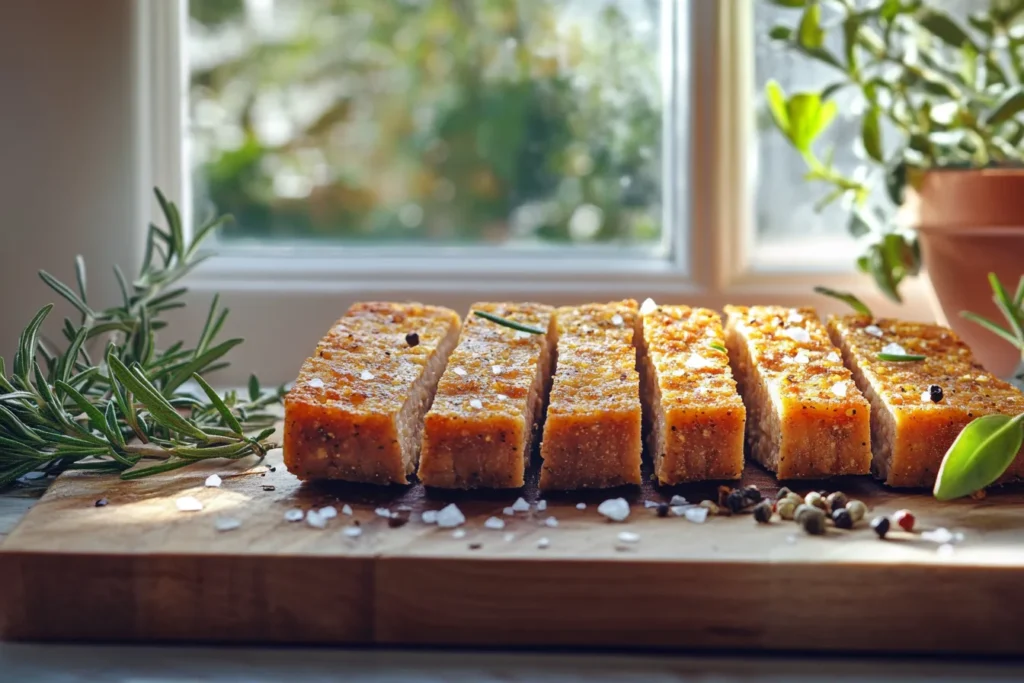Seitan Recipe: How to Make Perfect Seitan at Home (Tastes Just Like Meat!)
Table of Contents
Introduction
Have you ever bitten into a plant-based dish so good you had to double-check it wasn’t real meat? If not — get ready, because this seitan recipe is about to blow your mind.
I still remember the first time I made seitan at home. I wasn’t sure what to expect — honestly, the word seitan alone made me a little nervous (it sounds kinda intense, right?). But one bite and I was hooked.
Tender, chewy, packed with flavor… it was everything I loved about meat, but without any of the heaviness.
If you’ve been looking for the ultimate seitan recipe that’s easy, foolproof, and tastes just like meat, you’re in the right place. For a comprehensive guide on making seitan at home, check out this step-by-step tutorial. Whether you’re a long-time vegan, trying out Meatless Mondays, or just curious about homemade plant-based proteins, making your own seitan will seriously change your kitchen game.
Grab your apron — we’re about to make the best seitan you’ve ever tasted!
A Little Story
The first time I heard about seitan, I genuinely thought someone was trying to prank me.
“Seitan? Like, Satan? And you want me to eat it?”
Yeah… safe to say, I was a little skeptical.
But curiosity always wins with me. One chilly Saturday afternoon, I decided to try making a seitan recipe at home. I figured, worst case, I’d end up ordering pizza. Best case, I’d learn something new.
Spoiler alert: It was way easier than I expected and way messier too.
My kitchen looked like a flour bomb exploded. I wasn’t sure if the dough was too sticky, too dry, or just plain weird. I kneaded it like my life depended on it (turns out, you’re not supposed to knead it that much — classic beginner mistake).
When it came time to steam it, I wrapped the dough up so tightly in foil that it almost burst. I hovered over the steamer like an anxious parent, praying it wouldn’t turn into some rubbery blob.
And then magic.
As soon as I unwrapped the foil and sliced into it, I knew I had something special. The texture was unbelievable. Chewy, meaty, tender… honestly, it was better than a lot of actual meat dishes I’d eaten growing up. And the best part? It soaked up every bit of marinade and seasoning like a sponge.
That day totally changed the way I saw plant-based cooking.
Making my own seitan recipe wasn’t just about having a meat alternative. It was about creating something from scratch, with my own hands, and realizing that good food doesn’t have to come from a store or a fancy kitchen.
Now, making seitan is kind of a weekend ritual for me. I throw on some music, make a huge batch, and feel ridiculously proud every time I pull a fresh loaf of homemade seitan out of the steamer. It still blows my mind how something so simple can turn into something so satisfying.
If you’re feeling nervous about trying your first seitan recipe, trust me — you’ve got this. And even if it gets messy (because it probably will), that’s half the fun.

Why You’ll Love This Recipe
If you have never tried a homemade seitan recipe before, get ready to fall head over heels. Seriously, once you taste this, there’s no turning back to store-bought. Here’s why this recipe will become one of your kitchen staples:
1. Insanely Versatile
Grill it, sauté it, roast it, marinate it… This seitan can do it all. It fits into almost any dish where you’d usually use chicken, beef, or pork.
2. Unreal Texture
It’s chewy, firm, and juicy, just like meat. Honestly, even the most devoted carnivores might do a double take.
3. Meal Prep Dream
One batch makes plenty, and it freezes like a champ. That means quick, protein-packed meals all week long.
4. Packed with Plant-Based Protein
This seitan recipe is loaded with protein and low in fat, making it a powerhouse for plant-based diets.
5. Totally Customizable
You can flavor your seitan any way you want. Smoky BBQ, spicy buffalo, herby Italian — it’s a blank canvas for your tastebuds.
6. Easy and Budget-Friendly
Vital wheat gluten is pretty cheap, and once you get the hang of it, making seitan is way less expensive than buying pre-made meat alternatives.
Once you whip up this batch, you’ll wonder how you ever lived without it.
Ingredients You’ll Need
Here’s everything you’ll need to make this homemade seitan recipe a total success. Good news: it’s mostly pantry staples and easy to find in the US, UK, and Canada!
- 1 1/2 cups vital wheat gluten (about 180g)
The real MVP. It’s the protein part of wheat flour and gives seitan that perfect chewy texture. - 1/4 cup chickpea flour (about 30g)
A little chickpea flour softens the seitan slightly and adds extra protein. - 1/4 cup nutritional yeast (about 20g)
Adds a rich, savory, slightly cheesy flavor without any dairy. - 3/4 cup vegetable broth (180ml)
Infuses the dough with flavor. Go for a good-quality broth for the best results. - 2 tablespoons soy sauce or tamari
Brings a deep umami kick and that perfect salty balance. Tamari is a great gluten-free option. - 1 tablespoon olive oil
Adds a touch of richness and helps keep the seitan tender. - 1 teaspoon garlic powder
For that classic, mouthwatering savory base. - 1 teaspoon onion powder
Enhances the flavor with a sweet, mild oniony touch. - 1/2 teaspoon smoked paprika (optional, but highly recommended)
Adds a subtle smoky flavor that takes this seitan recipe to the next level. - 1/2 teaspoon salt Because seasoning matters.
- 1/4 teaspoon black pepper For a tiny kick of spice.
- If you’re interested in a quick and easy alternative, check out this 20-minute seitan recipe

Optional Add-ins
One of the coolest things about making your own seitan recipe is that you can totally make it your own. You can stick to the basics, or get creative and add a little extra flair to the dough before cooking. Here are some fun optional add-ins you might want to try:
Liquid Smoke (1 teaspoon)
If you want that deep, smoky BBQ flavor, a little liquid smoke goes a long way.
Cumin (1/2 teaspoon)
Adds a warm, earthy taste that’s amazing if you’re planning to use your seitan in tacos or chili.
Coriander (1/2 teaspoon)
Brightens up the flavor with a slightly citrusy note. Great for a fresher, lighter twist.
Maple Syrup (1 tablespoon)
A touch of sweetness balances out the savory flavors beautifully. Plus, it gives a gorgeous caramelized taste when you cook the seitan later.
Hot Sauce (1 to 2 teaspoons)
If you love a little kick, adding hot sauce to your dough brings a subtle heat all the way through.
Fresh Herbs (2 tablespoons, finely chopped)
Thyme, rosemary, sage, or even parsley can give your seitan an herby lift. Especially nice if you’re aiming for a chicken-style flavor.
Tomato Paste (1 tablespoon)
Adds a richer, deeper savory note — perfect if you’re making seitan for Italian-style dishes like pasta or pizza toppings.
Prep Time & Total Time
One of the best things about this seitan recipe is that it doesn’t take a crazy amount of time to make. Once you get the hang of it, you can whip up a batch without even thinking.
Here’s exactly what to expect:
- Prep Time: 15 minutes
Mixing the dough and getting everything ready is super quick. - Rest Time: 10 minutes
Letting the dough rest before cooking helps the gluten relax and makes it easier to work with. - Cook Time (Steaming): 1 hour
Seitan needs a good steam to get that perfect meaty texture. This is mostly hands-off — you can chill while it cooks! - Cooling Time: 15 minutes
It’s important to let the seitan cool a bit before slicing so it firms up nicely. - Total Time: About 1 hour 40 minutes

Recommended Kitchen Tools
Good news! you don’t need a fancy setup to make this seitan recipe at home. Most of the tools you probably already have sitting in your kitchen.
Here’s what you’ll need:
- Large Mixing Bowl
You’ll need a good-sized bowl to mix the dry and wet ingredients and knead the dough easily. - Measuring Cups and Spoons
Precision matters, especially when it comes to the vital wheat gluten. Using cups (and maybe a kitchen scale if you want to be extra accurate) helps nail the perfect texture. - Steamer Basket or Steaming Pot
Steaming is key to cooking seitan properly. If you have a bamboo steamer, metal steamer basket, or even a steaming rack inside a large pot, you’re good to go. - Foil or Parchment Paper
You’ll wrap the dough loosely before steaming to help it hold its shape and get that chewy, meaty texture. - Sharp Knife
For slicing the cooked seitan nice and clean once it’s done. - Optional: Instant Pot or Pressure Cooker
If you want to speed things up a little, you can steam your seitan in an Instant Pot. Just use the “steam” function and you’re set. - Little Tip:
No steamer? No problem. You can set a colander over a pot of simmering water, cover it with a lid, and DIY your way through it. Seitan isn’t fussy — it just needs some gentle steam to work its magic.
Step-by-Step Instructions
Here’s exactly how to make the perfect seitan recipe at home. Take your time, enjoy the process, and get ready for seriously delicious results.
Step 1: Mix the Dry Ingredients
In a large bowl, combine the vital wheat gluten, chickpea flour, nutritional yeast, garlic powder, onion powder, smoked paprika, salt, and pepper. Whisk them together until evenly mixed.
Step 2: Combine the Wet Ingredients
In a smaller bowl or measuring jug, stir together the vegetable broth, soy sauce, and olive oil.
Step 3: Make the Dough
Pour the wet ingredients into the dry ingredients. Stir with a spoon or your hands until a rough dough forms. It will look a little shaggy at first — that’s normal.
Step 4: Knead the Dough
Turn the dough onto a clean surface and knead it for about 3 to 5 minutes. You want it to feel firm and elastic but not overly tough. If you knead too long, it can get rubbery, so keep it quick and gentle.
Step 5: Rest the Dough
Let the dough rest for 10 minutes. This helps relax the gluten and makes shaping easier.
Step 6: Shape and Wrap
Divide the dough into two or three pieces, depending on how big you want them. Shape each piece into a rough log or patty. Wrap each one loosely in foil or parchment paper, leaving room for it to expand while steaming.
Step 7: Steam the Seitan
Place the wrapped dough in a steamer basket over simmering water. Cover and steam for 60 minutes, flipping them halfway through if possible. If you are using an Instant Pot, set it to “steam” for about 40 minutes.
Step 8: Let Cool
Once steamed, remove the seitan from the steamer and let it cool in the wrappers for about 15 minutes. This helps it firm up and makes slicing much easier.
Step 9: Unwrap and Use
Unwrap your seitan and it’s ready to slice, cook, marinate, or enjoy however you like. You can grill it, fry it, bake it, or simmer it in sauces.
Little Tip: Seitan tastes even better after resting overnight in the fridge. The texture becomes even more meaty and the flavors deepen.

Nutrition Info
Here’s the approximate nutrition per serving for this seitan recipe (based on 6 servings):
| Nutrient | Amount |
| Calories | 180 kcal |
| Protein | 21 grams |
| Fat | 4 grams |
| Carbohydrates | 7 grams |
| Fiber | 2 grams |
| Sodium | 400 milligrams |
Note:
Nutrition may vary slightly depending on the brand of broth, soy sauce, and any optional add-ins you use.
Healthy Variations
One of the best things about this seitan recipe is how easy it is to tweak it to fit your lifestyle. Whether you’re cutting back on salt, oil, or just looking for a little extra nutrition, there’s a simple way to make it work for you.
If you want to lower the sodium, just swap in a low-sodium vegetable broth and soy sauce. You’ll still get all that savory flavor without going overboard on salt, and your seitan recipe will stay just as delicious.
Looking to cut down on fat? You can skip the olive oil completely. The seitan will still turn out chewy and satisfying, just a little less rich. It’s a small change that makes a big difference if you’re watching your fat intake.
For a little extra fiber boost, try mixing a tablespoon of ground flaxseed into the dough. It blends right in and gives a subtle, nutty flavor while adding some extra goodness for your gut, making your seitan recipe even more nourishing.
Want to sneak more veggies into your meals? Fold a handful of finely chopped spinach, kale, or fresh herbs into the dough before you cook it. It’s an easy way to add color, nutrients, and a fresh taste without changing the texture too much.
And if you love a little heat, spice things up by adding cayenne pepper or crushed red pepper flakes to the mix. It gives your homemade seitan recipe a bold kick that’s perfect for wraps, tacos, or even grain bowls.
Small tweaks, big impact. With just a few easy swaps, you can customize this seitan recipe to fit exactly what you’re craving — and what your body needs.

Fun Ideas
Sure, you can keep things classic, but sometimes it’s fun to play around with your seitan recipe and get a little creative. Here are some fun twists you can try to switch things up:
Buffalo Seitan Bites
Toss cooked seitan chunks in buffalo sauce and bake them until crispy. Serve with vegan ranch or blue cheese dip for the ultimate game-day snack.
Breakfast Seitan Sausages
Shape the seitan dough into small patties and season with sage, fennel, and a pinch of maple syrup. Fry them up for a hearty plant-based breakfast that’s perfect alongside pancakes or avocado toast.
Seitan “Chicken” Nuggets
Cut the steamed seitan into nugget-sized pieces, coat them in breadcrumbs, and bake or air-fry until golden. They’re a hit with kids and adults alike.
Sticky BBQ Seitan
Simmer your seitan pieces in a thick, sweet barbecue sauce until they are sticky and caramelized. Serve with cornbread and coleslaw for a full Southern-style meal.
Crispy Seitan Sandwich
Bread and deep-fry slices of your seitan recipe to make an epic vegan “chicken” sandwich. Load it up with lettuce, tomato, pickles, and a creamy sauce.
Asian-Style Seitan Skewers
Marinate seitan cubes in soy sauce, ginger, garlic, and a splash of sesame oil, then grill or broil them. Serve with rice and a drizzle of spicy peanut sauce.
Holiday Roast
Shape the seitan into a loaf, wrap it in puff pastry, and bake it for an impressive holiday centerpiece. Add some cranberry sauce on the side for extra festive flavor.
With a little imagination, this seitan recipe becomes the perfect base for tons of fun, tasty meals that everyone will love — whether they’re vegan or just curious.
Mistakes to Avoid
Making seitan at home is surprisingly simple, but there are a few common mistakes that can mess up even the best seitan recipe. Here’s what to watch out for:
Over-Kneading the Dough
It’s tempting to knead a lot because we usually think more kneading means better texture. But with seitan, over-kneading makes it too rubbery and tough. Knead just until the dough comes together and feels firm but not stiff.
Wrapping the Dough Too Tightly
When steaming, your dough needs space to expand. If you wrap it too tightly in foil or parchment, it can get dense and heavy. Leave a little breathing room when you wrap it up.
Skipping the Rest Time
After kneading, let the dough rest for about 10 minutes. This step relaxes the gluten and makes the dough much easier to shape. If you skip it, your seitan might end up uneven or hard to handle.
Steaming for Too Little Time
Undercooked seitan can be gummy inside. Make sure to steam for the full hour so the dough cooks all the way through and develops that perfect chewy bite that makes this seitan recipe so good.
Cutting It Too Soon
Let your seitan cool down after steaming. If you slice it while it’s still hot, it can fall apart. Cooling helps it firm up and gives you cleaner cuts.
Ignoring the Flavors
Seitan on its own is a blank canvas. If you don’t season the dough or marinate it after cooking, it can taste bland. Make sure you pack in the flavors from the start or plan to marinate it later.
Using Boiling Water Instead of Simmering
If you’re simmering instead of steaming, always keep the water at a gentle simmer. Boiling can make seitan puff up weirdly and turn spongy.
By avoiding these small mistakes, you’ll end up with a seitan recipe that’s firm, flavorful, and absolutely delicious every single time.

Storage & Make-Ahead Tips
One of the best things about making your own seitan recipe is how well it keeps. You can easily make a big batch and enjoy it all week long, or freeze it for later. Here’s how to store it right:
In the Fridge
Once your seitan has cooled completely, transfer it to an airtight container or wrap it tightly in foil. It will stay fresh in the fridge for up to 7 days. Perfect for quick lunches, stir-fries, or sandwiches whenever you need a protein boost.
In the Freezer
If you want to store your seitan recipe longer, freezing is a great option. Slice or cut it into portions first, then wrap each piece in foil or parchment paper and place them in a freezer-safe bag. It will keep for up to 3 months. When you’re ready to use it, thaw overnight in the fridge or gently reheat in a pan.
Make-Ahead Tips
You can prepare the dough a day in advance and keep it in the fridge wrapped tightly before steaming. Letting the dough rest overnight can actually improve the texture and make it even meatier once cooked.
After steaming, seitan also benefits from chilling. Let it sit in the fridge for a few hours or overnight before using it. The flavors settle and the texture firms up beautifully.
Quick Reheat
To reheat cooked seitan, simply sauté it in a pan with a little oil, warm it in a sauce, or pop it in the microwave for a minute or two. Avoid overcooking it when reheating so it stays tender and juicy.
With these easy storage and make-ahead tips, your seitan recipe will always be ready to power up your meals whenever you need it.
Conclusion
Making your own seitan recipe at home might feel a little intimidating at first, but once you try it, you’ll wonder why you didn’t start sooner. It’s simple, satisfying, and honestly a lot of fun.
With just a few basic ingredients and some easy steps, you can create a homemade plant-based protein that’s chewy, flavorful, and incredibly versatile. For a quick and simple method, you might find this easy seitan recipe particularly helpful. Whether you grill it, sauté it, toss it into sandwiches or stir-fries, this seitan recipe will quickly become a favorite in your kitchen.
Don’t worry if your first batch isn’t perfect. Every time you make seitan, you’ll get a little better at feeling the dough, adjusting the flavors, and making it truly your own. That’s part of the magic.
So go ahead — roll up your sleeves, mix that dough, and create something amazing. Once you taste your homemade seitan recipe, you’ll never look at store-bought meat alternatives the same way again.

FAQ
Can I bake seitan instead of steaming it?
Yes, you can bake seitan after steaming it if you want a firmer or slightly crispy texture. Some recipes even bake seitan without steaming first, but for this seitan recipe, steaming ensures the inside stays tender and juicy before you finish it with baking if you like.
What does seitan taste like?
Seitan itself has a mild, savory flavor that soaks up whatever seasonings or marinades you use. That’s why this seitan recipe is so versatile — you can make it smoky, spicy, herby, or even a little sweet depending on how you flavor it.
Is seitan healthy?
Yes, seitan is high in protein and low in fat, making it a great option for plant-based diets. This seitan recipe gives you a clean, simple way to add more protein to your meals without all the extra additives you sometimes find in store-bought meat alternatives.
Can I freeze seitan?
Absolutely. Once cooked and cooled, you can slice your seitan and freeze it for up to three months. Freezing makes it super easy to meal prep and always have some ready when you need a quick, protein-packed meal.
Why is my seitan rubbery?
If your seitan turns out rubbery, it’s usually because the dough was over-kneaded or it was steamed for too long at too high a heat. Follow the kneading and cooking times closely in this seitan recipe to get that perfect chewy but tender texture.
Can I flavor the seitan after cooking it?
Yes, one of the best things about seitan is that it continues to absorb flavors even after it’s cooked. Marinate it, simmer it in sauces, or fry it up with spices to give it whatever flavor you’re craving.
Is this seitan recipe gluten-free?
Unfortunately, no. Seitan is made from vital wheat gluten, which is pure gluten. If you need a gluten-free alternative, you might want to try recipes that use tofu or tempeh instead.


